|
Facts
About Nepal
Nepal
is a Kingdom of high Himalayan mountains, artistic monuments,
exotic wildlife and diverse cultures. It is the land where Lord
Buddha was born over 2,500 years ago. Roughly rectangular in
shape, the Kingdom of Nepal is situated between China to the
north and India to the south. The land extends approximately
885 km east to west, and 193 km north to south. Nepal is primarily
an agricultural country. Tourism, carpets and garments are the
major industries.
THE
LAND:
The terrain rises from the Terai, the southern plains covered
with tropical jungles and fertile farm- land at almost sea level,
to the high Himalaya mountains in the north -with valleys and
lush hills in between -with- in a distance of less than 200
km. Eight of the 10 highest peaks in the world lie in Nepal. |
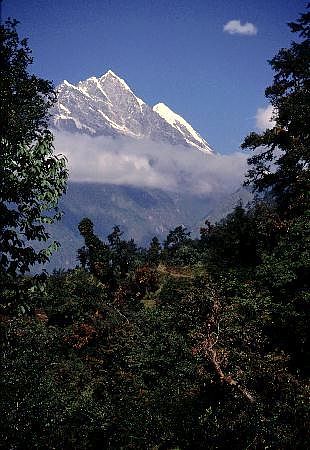 |
Basic
Information:
|
Official
name
|
Nepal
Adhirajya (Kingdom of Nepal)
|
|
Area
|
3 147.181 Sq. kms
|
|
Inhabitants
|
23.5 million
|
|
Capital
|
Kathmandu
|
|
Political
System
|
Multiparty
Democracy with Constitutional Monarch
|
|
Official Language(s)
|
Nepali
|
|
Religious
Groups
|
Hindus
(89.5%), Buddhists (5.3%), Muslims (2.7%), Jains (0.1%), Christians
& others (0.023%)
|
|
Curreny
|
Nepalese
Rupee (NR)
|
|
National
Holiday
|
07 July (Birthday of the King)
|
 |
Capital of Nepal, the mystical valley-Kathmandu
is Nepal's biggest and most cosmopolitan city, a meeting
place of a dozen ethnic groups, and the home town of the
Newars |
 |
The ancient city of
Patan, lying 5 km
southeast of Kathmandu, is known as the city of fine arts.
The diversity of the medieval culture has left a rich
legacy of impressive sightseeing in this city for today's
visitors.
|
 |
Situated at an altitude of 1,401 m,
Bhaktapur
(or Bhadgaon as popularly know as) covers an
area of four square miles. Bhaktapur or "the City of
Devotees" still retains the medieval charm and
visitors to this ancient town are treated myriad wonders
of cultural and artistic achievements. |
 |
If Kathmandu is the cultural hub of Nepal,
Pokhara
is its center of adventure. An enchanting city nestled in
a tranquil valley, it is the starting point for many of
Nepal's most popular trekking and rafting destinations. |
 |
The township of
Tansen bears a rich
legacy of the traditional art and architecture. Perched on
the lap of the spectacular Srinagar Danda (hill) Tansen,
commands a gorgeous panorama of the Himalayas as well as
the plains of Terai.
|
 |
Gorkha is a scenic hill- town with
great historical significance Situated on a small hillock
at an attitude of about 1000 m, Gorkha offers panoramic
view of snow-fed mountain. |
 |
A visit to Nepal remains incomplete without
seeing the beauty of the Terai. And Chitwan is the
best place to do so.The Royal Chitwan National Park,
established in 1973, provides a great wildlife experience
with its rich flora and fauna.
|
 |
Lumbini-a place in the South-Western
Terai of Nepal, evokes a kind of holy sentiment to the
millions of Buddhists all over the world, Lumbini and its
surrounding area is endowed with a rich natural setting .
|
 |
Named after the legendary King Janak,
Janakpur
was the capital of the ancient Indian Kingdom Mithila, the
native country of goddess Sita, the wife of god
Rama and the heroine of the great Hindu epic Ramayana.
Today Janakpur stands as the most cleanest & interesting
place among all the towns of Terai. |
The
basic requirements that are needed at the Nepal airport are the
visa which one can purchase upon arrival at Tribhuvan International
Airport in Kathmandu and at all other ports of entry by paying
30 dollars which is a necessary requirement. Also one has to give
2 copies of passport and 2 passport size photographs.
Travellers occasionally report immigration difficulties in crossing
the Nepal-China border overland in either direction. U.S. citizens
planning to travel to Tibet from Nepal may contact the U.S. Embassy
in Kathmandu for current information on the status of the border-crossing
points. Travellers may also wish to check with the People's Republic
of China Embassy in Nepal for current regulations for entry into
Tibet.
TOP
Nepalese
currency is the rupee (abbrev. Rs.) which is divided into 100
paisa.. Bank notes come in denominations of 1000, 500, 100, 50,
25, 20, 10, 5, 2 and 1 rupees. When
you change your money in Nepali currency, do it at the branch
of a bank or go to an authorized moneychanger. Get an encashment
receipt from the moneychanger. It helps you to reconvert the leftover
Nepali currency.
In
metropolitan or other major cities, it is possible to change currency
at airports, hotels and banks. In small towns there may be a little
problem. So change your money before you go to a small town. It
may be advisable to bring some US dollars or British pounds, which
can exchange more easily in smaller tourist centers
TOP
Climate
: Nepal is a land of extreme contrasts as far as the climatic
conditions are concerned. It has through its deep lands a tropical
temperature and mountainous faces which are covered with snow
throughout giving it an eternal look. Nepal has a climate that
ranges from subtropical summers with mild winters in the southern
lowlands to an alpine climate with cool summers as well as severe
winters in the mountains. Average temperature ranges in Kathmandu
are from 2 to 20 degree Celsius (36 to 73 degrees Fahrenheit)
in January & 20 to 29 degree Celsius in July.
Nepal has four climatic seasons
(a) Spring : March-May
(b) Summer : June-August
(c) Autumn : September-November
(d) Winter : December-February. |
Rainfall
: The monsoon season comes immediately after Summers,
its effect is observed for a long period from June to September.
There are regions covered with little snow which become a centre
of attraction for the tourists.
Average temperature and rainfall in Kathmandu:
Nepal
has a monsoon type climate. Being in the Northern Hemisphere,
the summertime here is the rainy season in Nepal. The Springtime
is warmer than the autumn but temperatures vary enormously depending
on the altitude. In the high mountains the temperature may drop
to below zero whilst in the Kathmandu valley, daytime temperature
rarely drop below 10 degrees Celsius, and may reach 30 degrees
in April and May. Pokhara is usually warmer than Kathmandu but
with higher range of annual rainfall. The Chitwan area to the
South may be warmer still, so a visit to Nepal requires variety
of clothing.
TOP
 |
WHAT
TO WEAR: Medium-weight and easy-to-wash cottons can be a good
choice year-round in the Kathmandu Valley. From October to February,
woolen sweaters, jackets or similar other warm outfits are necessary.
|
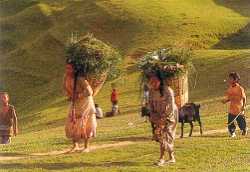 |
|
Short or long-sleeved shirts are good March through May. From
June to September, light and loose garments are advisable. |
TOP
|
Hinduism
and Buddhism constitute two major religions of Nepal. A remarkable feature
of Nepal is the religious homogeneity what exists, particularly between
the Hindu and Buddhist Communities. Apart from the Hindus and Buddhists,
Muslim from the third largest religious group. The exquisite medieval Art
& Architecture of the Kathmandu Valley vividly reflect the artistic
ingenuity and the religious tradition of the people.
|

|
TOP
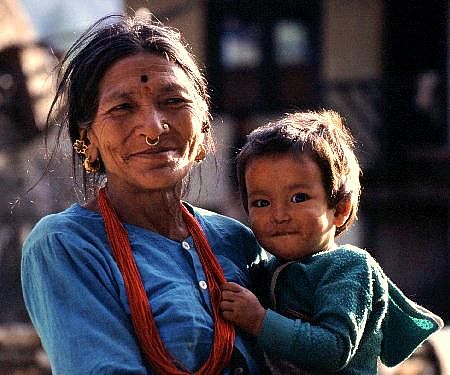 |
Nepal's many ethnic groups are as varied as its land with their
own languages and cultures. In the Kathmandu Valley are the Newars,
whose culture and artistry have earned them an international reputation.
The Sherpas of the Himalaya are known as tough mountain climbers.
Brahmins and Chhetris are scattered over the hills and valleys,
and Tamangs are found in the districts around the Kathmandu Valley.
|

|
|
The Rais, Limbus, Magars and Gurungs of the mid-hills have earned
fame as Gurkha soldiers. Lowland ethnic groups such as the Maithili,
Bhojpuri and Tharu enhance the colorful mosaic. The population
of Nepal is about 22 million. |
TOP
Nepali,
written in the Devanagari script, is the national language as
well as the lingua franca for Nepal's diverse communities. Many
languages and dialects are spoken in the Kingdom, however, only
six (Nepali, Maithili, Bhojpuri, Tharu, Tamang and Nepalbhasa)
are spoken by more than half a million people. English and Hindi
are widely understood in the urban centers and areas frequented
by tourists.
TOP
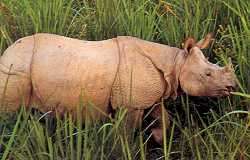 |
Nepal
provides shelter to over 30 species of large wild animals and
approximately 180 species of mammals. The rhinoceros, tiger, crocodile,
snow leopard, red panda, |
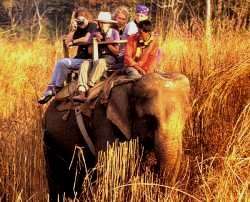 |
| Himalayan black bear and many other beasts
are found in Nepal's jungles. Nepal is also a haven for birds
and over 800 species, representing approximately 10% of the world's
population, are found here. There are more than 650 species of
butterflies and over 6,000 species of moths. |
TOP
THE
Nepali Kitchen: The Nepali kitchen is somewhat similar to
Indian kitchen. The various dishes prepared are similar to Indian
dishes. In Nepal rice is the most commonly used food, in most
of the starred hotels almost all the 3 meals comprise of rice.
The typical Nepali meal consists of Dal -Bhat which is a mixture
of rice, pulses and vegetables. The menu in Nepal comprises varieties
of Indian, Chinese, Mexican, Italian and German dishes. Nepali
food is generally very spicy and very hot as well. It is eaten
without starters, soups or courses. A typical Nepali meal consists
of rice, at least one lentil curry called daal, one or more vegetarian
servings, meat and/or fish, chutneys and pickles. Nepali food
is basically vegetarian, non-vegetarian item is not a part of
the daily menu here.
Nepal is a Hindu country and so you will not see any beef items
on the menu here. In Hindu religion cows are sacred, so in Nepal
it is illegal to slay them for food and one can be punished for
it.
TOP
Alcoholic
Drinks
Although
many Indians shun alcohol, specially the women, the upper crust
of society do enjoy alcoholic drink, which are a luxury for most
Indians.
Imported liquors like Scotch whisky are very much prized. But
Indian-made whiskies, rums, and brandy are not far behind their
western counterparts. These are also popular with foreign residents.
There
are some 30 varieties of Indian beer available. Popular brands
are kingfisher, Hayward and rosy pelican. Indian beer is good.
Alcoholic
drinks and better must be bought from licensed shops. India does
not produce high quality wines. Try them for their taste. Who
knows you may like them?
Drinking
in public is prohibited and is not desirable. You are welcome
to drink in your hotel room or in the hotel bar if you want company.
Some Indian states enforce prohibition-especially Gujarat and
Tamil Nadu. But foreigners in hotels can get permit for drinking.
Nepal
has the 220v, 50-cycle system of electricity. Most hotels can
provide step-down transformers to enable you use your electrical
appliances.
TOP
While
roaming in the markets of Nepal, one could see that Nepal is highly
influenced by the Hinduism & Buddhism; all the masks and the
figures are overwhelmed with the Hindu and Boddhist style. Also
one can find a number of items based on Hinduism &
Buddhism. When you reach to the different shops, the handler offers
you many items and thus, there is a variety to select. The customers
are expected to proper bargain as the first price quoted is always
higher than the price that will eventually be accepted for commodities.
The main commodities to select are: leather jackets, the hand
made belts, statues of Lord Buddha, wooden toys and decorated
metal knives.
|
 |
|
Kathmandu is also a shoppers' paradise.. The most popular shopping
items in Kathmandu are - Tibetan carpets, Jewellery, pottery,
clothing and art and craft items. Varieties of hand-made garments
includes shawls, sweaters, trousers and caps which are
functional and colourful items. Exceptional embroidery also goes
into work. Thus a variety to purchase is there.
TOP |
|


























